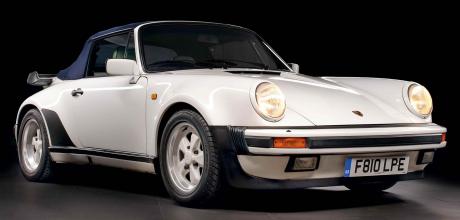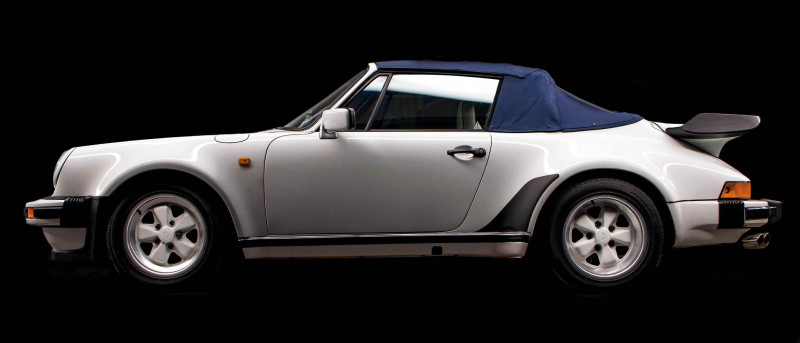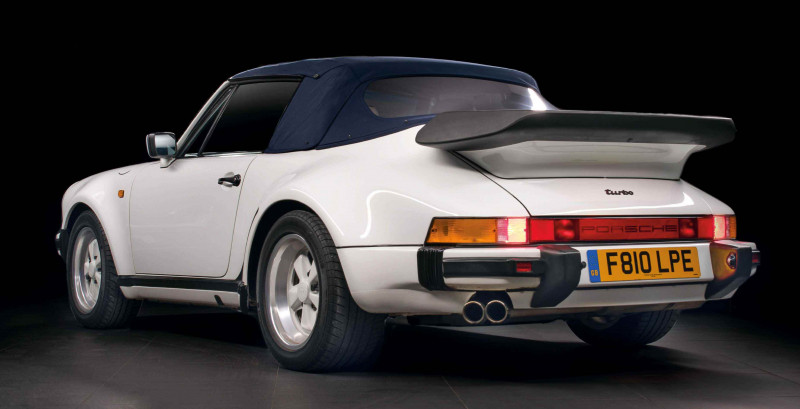Porsche 930 Turbo

The iconic yet practical supercar that would define Porsche presents a rewarding ownership opportunity for the enthusiast – if you buy the right example. Total 911 shows you what to look for…
Porsche Index: 930 Turbo. Written by Kieron Fennelly. Photography by Damian Blades.
Want to buy yourself a 930 Turbo? Our expert guide reveals everything you need to know
HISTORY AND TECH
In a magazine interview in late 1987, Tony Lapine suggested that it was really Ernst Fuhrmann, not Butzi, who ‘made’ the 911. The ruling Porsche and Piëch families were appalled at this heresy and Lapine, who subsequently suffered a heart attack, would never return to the company. But in a sense, he was right. In 1974 the 911 was a brilliant, unsurpassed sports car, the default choice of the keen driver, but its wider public reputation would come about thanks to the Turbo, the car with bodywork as outrageous as its acceleration, the sportscar that the stars wanted to be seen in: the Porsche Turbo broke all the rules.

A turbocharged Porsche was not a new idea: Piëch had had Valentin Schäffer carry out some experiments in 1969, but it was Fuhrmann who seized the opportunity. Experience in the Can-Am had shown that Mezger’s boxer engines (the 917 was effectively two flat sixes) tolerated the additional stress of boosting with little reinforcement. Post 917, Porsche needed a new competition model to get back into racing and turbocharging the existing 911 would also give the company a flagship model while the 928, which Fuhrmann saw as the future for Porsche, was readied in the wings. The 930 was a brilliant yet simple idea that Porsche executed with aplomb.

Initially built to homologate the 911 for Group 3 racing, the 930 was equipped with competition suspension parts and 8-inch rear rims which required substantially wider wings to accommodate them, as well as the ‘whale tail’ already used by the RSR. It also incorporated the 3-litre flat six developed for the RSR, but detuned with a 6.5:1 compression ratio, and breathing through Bosch K Jetronic injection and of course, the single KKK turbocharger. It was not so much the 150mph top speed as the way it got there which made its reputation. The sudden thrust of the turbocharger above 3,000rpm was intoxicating and unique: the appeal to those who could afford it was obvious and in the popular mind, ‘Porsche Turbo’ became synonymous with high living and unfettered speed.
In its 13-year career the 930 changed little: its tyre sizes increased, the only visual change, although the observant might also have spotted the bigger, 917-derived brake calipers on post-1977 cars. MY1978 also brought the most significant change: as well as the bigger brakes, enlarging bore and stroke, making 3,299cc, and feeding the turbo through an intercooler increased both torque and power by 20 per cent and endowed the 911 Turbo with performance that no 1980s competitor would approach.
WHAT’S IT LIKE TO DRIVE?
The Porsche Turbo’s ‘widow-maker’ reputation came of course from the way the power arrived abruptly, catching the unwary, sometimes with disastrous consequences. Although Porsche had attempted to configure the cylinder head and ignition settings to offset turbo lag, it was only partly successful and René Metge, future Dakar winner for Porsche, recalled how unmanageable the early 930 could be on the wet cobblestones of Paris’s broad avenues. Exploiting to the full the 930’s propensity to spin its rear tyres, Nick Faure famously wore its Pirellis down to the cords in an afternoon at Castle Combe power sliding AFN’s 3-litre demonstrator for the benefit of journalists. In reality, driving a 930 today is not as daunting a prospect as some of the more lurid stories might suggest. Writing in 2007, Jeff Daniels put matters in perspective when he said that driven gently, the 930 was good natured with none of the plug-oiling or temperament which afflicted some of its highly strung competitors. Even when pressing on, the 930 remained calm, quietly understeering and easy to handle up to 80 per cent of its limit, but that extracting the last 20 per cent required both skill and hard work with the steering wheel. Peter Morgan, who has written extensively about air-cooled 911s, advises that to enjoy driving the 930, the driver needs to keep the revs between 3-5,000rpm.
Clearly the 930 is the antithesis of the modern car where 90 per cent of the thinking is done for the driver: the original Turbo really does require those vanishing skills, feel and technical sympathy, but getting it right and driving within the capacity of the car is immensely satisfying.
THE VALUES STORY
By 1980 the SC retailed at £16,700 whilst the Turbo cost £27,950, yet demand never wavered and when the end of production came in 1989, Turbo prices shot up and cars briefly changed hands for up to £100,000. Although they would fall back, the 930 would experience none of the severe depreciation which saw tired SCs selling for well below £10,000 in the early 2000s. After the financial crash of 2009-10, air-cooled prices rose quickly, none more so than the 930’s which reached its zenith in 2015-16. Since then, a substantial range of pricing has developed; 930s are commonly advertised between £60- 80,000, but other examples are offered at £150,000+. The original 3-litre cars are rare enough to be pure collectors’ fare, and the SE and LE versions of 1987-9 often went straight into collections or led pampered lives, and their sometimes £200,000+ asking prices reflect this.
BUYING ONE
Today the 930 is a 35 to 45-year-old car and it has all the corrosion pitfalls of the G series – the ‘kidney bowls’ at the base of the B pillars, wings rusting through, alloy bumpers which corrode from the inside to name but a few of the usual problems. The flat six too will need to have been rebuilt at some point, a £5,000 outlay, without taking into account any work required on the turbocharger. The exhaust is complex and original Porsche replacement systems cost £4,000; heat exchangers at £1,500, are similarly expensive. It is also worth noting that the synchromesh on the four-speed gearbox weakens, manifested by difficulty engaging second and third. Clonks and rattles from the suspension usually point to worn bushes and anti-roll bars, nevertheless a suspension rebuild with Bilstein dampers will not leave much change from £5,000.
Generally speaking, the later cars, post 1986 with a Motronic DME (which improved torque and mpg) and post 1987 with five speeds are a better bet, but the criterion is condition. A £70,000 930 may appear attractive, but it could cost almost as much again to make it absolutely right. Colin Belton of Ninemeister speaks with the authority of an air-cooled 911 specialist and as an owner: in 2016 he acquired a black 930, and once he started looking at improvements, correction of one fault simply exposed another, “the very definition of mission creep,” he says ruefully. After five years’ work, he has an exceptional 930, but only after spending considerably more than the £50,000 he paid for it in the first place.
His advice to 930 buyers is to look for evidence of meticulous maintenance and dry storage. Any 40-year-old 911 will have corrosion and signs of wear and tear, which is how comprehensively restored examples can command £150,000. “A good, usable 930 will be expensive,” he cautions. The alternative is to identify a sound, sympathetically restored 930 around £80,000 where critical engine, gearbox and bodywork issues have received attention and finish the improvement process oneself. Even then, a buyer could spend upwards of £20,000 refurbishing a tired interior and obtaining a proper respray, a particularly labour-intensive process because of the amount of dismantling involved.
A Porsche fan determined on the 930 would clearly be advised to look at the top end of pricing, at the same time assessing any requirement for potential further expenditure. Purchasing a 930 calls for professional inspection for all buyers but real 911 experts. “If it is completely right, then the 930 is a great car, a real icon, but the buyer must go into it with eyes wide open,” says Belton.
DESIRABLE OPTIONS
The 930 was marketed with a full leather interior and just about every accessory Porsche could build into it, including a boost gauge. A/C was not always fitted to European-specification cars so is worth seeking out; surprisingly most 930s have only a four-speed gearbox developed largely from racing. Anticipating that the five-speed 915 would rapidly be overwhelmed by the Turbo’s torque, a specific 930 gearbox was fitted and only 1989MY Turbos have a five-speed derived from the G50. The additional ratio does improve the driving experience, particularly in traffic.
Some cars had sunroofs, and unusual colours such as Siena metallic add value. Genuine Sonderwünsch upgrades and in particular the X33 engine kit are rare and such cars are usually found at the top end of 930 pricing.
BELOW Cabriolet and ultra-rare Targa body styles were introduced on the 930 from 1987
BELOW The 930's interior was lavishly optioned as standard. Motronic engine management arrived in 1986, five-speed 'box was introduced in 1989.
RIGHT Revised rear spoiler design in 1978 housed the intercooler as part of the 930's overhaul from 3.0 to 3.3 litres.
INVESTMENT POTENTIAL
Porsche built a total of 19,500 930s and at least three-quarters of them have survived. Because it always retained much of its value, the 930 was probably the first 911 to be worth restoring (closely followed by the Carrera 2.7 RS) and the upshot is that there is no shortage of them for sale today. In terms of investment potential, although it would be flippant to say that the 930 has a great investment future behind it, there are rarer Porsche models which might do better long-term. The early 3-litre 930, of which about 2,500 were made (figures vary) is, if less driveable, a genuine collectible, as are the low-production special editions of 1987-9 and of course the 330PS 930S. Above all, and especially if bought judiciously, a good 930 Turbo should be a car to drive and enjoy, using regularly without too many worries about absolute originality or mileage, and will at least retain its purchase value.
“A good 930 Turbo should be a car to drive and enjoy”
TOTAL 911 VERDICT
The 930 is an automotive landmark, defining the wider public’s perception of sports cars, like Malcolm Sayer’s Jaguar E-type a decade earlier. But owning and driving an automotive landmark (as opposed to keeping it in a climatised vault) is a different proposition which will not suit everybody. The 930, at least the more common 3.3 version, is a practical third car which like all air-cooled flat sixes, thrives on regular use, but which, with its turbo and associated plumbing, will also need more attentive maintenance. That said, properly fettled the 930 will take readily to being driven in the way Porsche intended, a skill which for generations raised on assisted steering and automatic transmissions may have to be learned. But for the thinking driver, the intense involvement of pressing on in a 930 along a known, dry road is to experience a motoring nirvana which is slowly being legislated away. But ensuring that you acquire a sound example is an absolute prerequisite.
THANKS The stunning 930 Cabriolet in our pictures was supplied by First Choice Detailing. For more information visit firstchoicedetailing.co.uk or call +44 (0) 1202 096096
MARKET RIVALS
Most 930s on offer fall in between £60- 140,000, opening a choice of both air-cooled and modern 911 possibilities.
GT3 997
The last of the analogue 911s, at around £100,000 the 997 GT3 is a serious driver’s car, immensely fast, obviously vastly more modern than a 930, but still demanding and less relaxed than the 930 at gentler velocities.
993 Turbo
Generally priced from £130,000, the twin-turbo 993 both tames the worst of turbo lag and adds the security of AWD, but feels more GT than sports car. Much rarer than a 930, less prone to corrosion and perhaps a better long-term investment.
2.2E
The best S versions of the 2.2 and 2.4 tend to be priced around £150,000, but the E with 35 fewer horses is easier-going and costs about 30 per cent less. For similar money an air-conditioned 930 is probably a better bet for longer journeys, though potentially-more expensive to own.
964 C4 '30 Jahre'
The naturally aspirated wide-body air-cooled 911s all tend to be collectors’ items: the handsome 30 Jahre 964 is a case in point at About £100,000, and the same money might also buy a low-mileage 3.2 Supersport Cabriolet if An open 911 is preferred.

